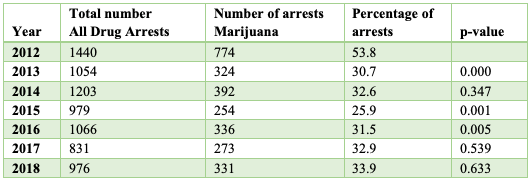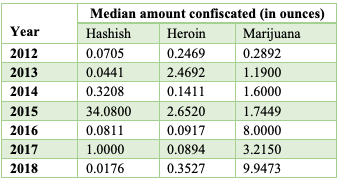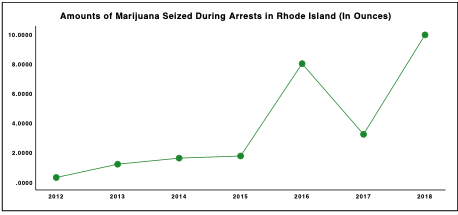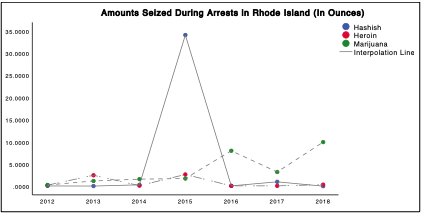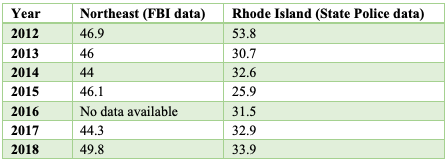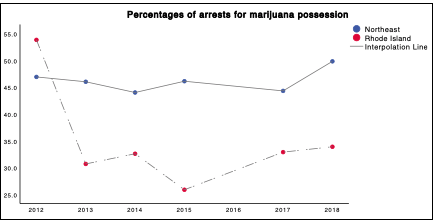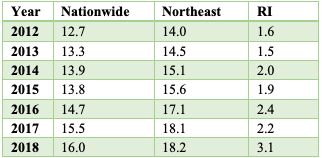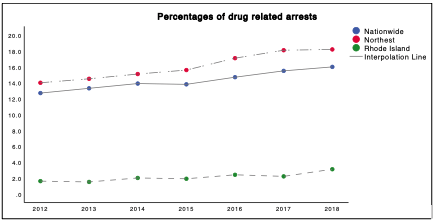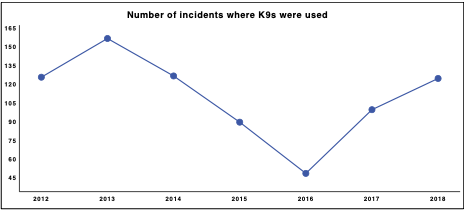Abigail Kojoian ’21
The Impact of Decriminalizing Marijuana in Rhode Island on the Number of Narcotic Related Arrests and Quantities Seized
Abigail Kojoian ’21
Major: Mathematics
Minor: Classics
Faculty Mentor: Dr. Asta Shomberg, Mathematics
Introduction
Beginning in 2006 with the Edward O. Hawkins and Thomas C. Slader Medical Marijuana Act, laws regarding the use of marijuana have been a topic of concern for the State of Rhode Island. According to this act, which was passed on January 3, 2006, a person given legal permission to obtain and use marijuana for medicinal purposes shall not be arrested or prosecuted for possessing or utilizing medical marijuana.1 Since this act was passed, other laws regarding the possession of this narcotic have also been enacted. One of the more recent laws concerning marijuana was passed in 2012 by the State of Rhode Island, decriminalizing the possession of small amounts of marijuana. Effective beginning on April 1, 2013, this law states that “the possession of one ounce (1 oz.) or less of marijuana by a person who is eighteen (18) years of age or older…shall constitute a civil offense, rendering the offender liable to a civil penalty in the amount of one hundred fifty dollars ($150) and forfeiture of the marijuana, but not to any other form of criminal or civil punishment or disqualification.”2
There are varying opinions concerning the decriminalization of marijuana. Supporters of decriminalizing and legalizing marijuana believe that alcohol or cigarettes are just as dangerous as marijuana use. Still others argue that there are health benefits associated with the use of this narcotic. People opposing these conjectures, however, assert that this drug is harmful, especially to young people. Moreover, these individuals believe that marijuana introduces people to drug use, and its effects encourage the desire for higher order drugs; hence marijuana is also called the gateway drug.3
In a paper written by Denise B. Kandel, the author references a study conducted by Lynskey et al, who concluded that “early marijuana use by itself, even after control for other covariates, increases significantly the use of other illicit drugs.”4 Additionally, a study conducted by Jeffrey DeSimone shows that people who use marijuana are “more likely to use cocaine because of the substantial effect of marijuana use itself.” Moreover, DeSimone also found that marijuana use increases the probability of cocaine use by twenty-nine percentage points.5. A third paper written by Clifford F. Thies and Charles A. Register, also discovered similar findings in that the decriminalization of marijuana can lead to “increased experimentation with more powerful drugs.” Their research also concluded that in comparison to states where marijuana is not decriminalized, states that have decriminalized marijuana have higher drug use rates.9
An important reason for conducting our study lies in the relationship between drug abuse and violence. According to an article written by Diana Fishbein,6 chronic drug use, among other things, can damage the brain and disrupt an individual’s “ability to assess consequences and regulate impulses.” Moreover, habitual drug abuse “can lead to impaired prefrontal function, contributing to a greater incidence of violence among drug abusers.” For this reason, drug users
experience difficulties controlling their impulses, and thus a connection is formed between drug abuse and violence. In another study entitled Violent Behavior as Related to Use of Marijuana and Other Drugs, it was found that the use of heroin and other opiates was associated with more violent crimes than the use of alcohol. These crimes included “Robbery, and Attempted Homicide/Reckless Endangerment.” Moreover, people who use marijuana display violent behaviors comparable to the violent behaviors of those who have consumed alcohol. 7
The purpose of our study was to examine the various changes that have occurred in Rhode Island since marijuana was decriminalized in 2013. First, we investigated how the decriminalization of marijuana in 2013 has affected the number of arrests for marijuana possession in Rhode Island. Additionally, we addressed the question of whether the number of other drug related arrests has changed due to this decriminalization. The third goal of our study was to determine if the quantity of drugs, namely marijuana, seized from these drug arrests has changed. The final question addressed in this research was whether the Rhode Island State Police K9 Unit has been utilized more frequently since this decriminalization in 2013.
Originally, this research project was going to examine the utility of narcotics sniffing K9s in facilitating drug arrests by the Rhode Island State Police. From conversations with State Troopers, we learned that K9s are trained to detect six drugs within Schedules I and II—drugs that have the highest potential for psychological and physical dependence. The six drugs that K9s can detect are: Crack Cocaine, Cocaine, Hashish, Heroin, Marijuana, and Methamphetamines/Amphetamines. We were not able to obtain information about the presence of K9s at drug arrests made by the Rhode Island State Police. Instead, we were granted access to Incident Case Status Reports, which indicate each instance in which a K9 was utilized to search for a suspected narcotic. These reports, however, do not provide information about whether an arrest was made. In this regard, these reports cannot be utilized to determine if K9 presence at drug arrests has increased since marijuana was decriminalized.
Materials
To conduct this research, we obtained official arrest data and incident reports from the Rhode Island State Police Office of Legal Counsel. These data included information on the number of drug related arrests and quantities of narcotics seized during each arrest made by Rhode Island State Troopers from January 1, 2012 to December 31, 2018. In addition to the data regarding drug arrests, data pertaining to Rhode Island State Police K9 use was also involved in this study. To determine how the utilization of K9s has changed since marijuana was decriminalized, we were granted access to Rhode Island State Police K9 Incident Case Status Reports from January 1, 2012 to December 31, 2018. Finally, we obtained data on the total number of arrests for all crimes conducted by the Rhode Island State Police for the time period beginning on January 1, 2012 to December 31, 2018.
In addition to data obtained from the Rhode Island State Police, this research also drew from numerical evidence provided by the Federal Bureau of Investigation (FBI).8 These data
reflected the total number of drug related arrests per year as well as all arrests for any crime per year and was categorized by region (i.e. the Northeast) and the Nation. The FBI data coupled with the data from the Rhode Island State Police was used to make comparisons between Rhode Island, the Northeast, and the Nation.
Statistical Analysis and Results
We analyzed the data provided by the Rhode Island State Police Legal Department to answer multiple questions. We began by comparing the number of drug related arrests from 2012 to 2018. The comparisons that resulted in p-value ≤ 0.05 were declared statistically significant. Note: Column four of Table 1 entitled “Percentage of arrests” represents the percentage of marijuana arrests out of all drug arrests.
As one can see from Table 1, there have been several statistically significant changes in the number of marijuana related arrests. We observed a significant decrease in the number of arrests from the year 2012 to 2013, and from 2014 to 2015. However, the number of marijuana related arrests increased significantly from the year 2015 to 2016.
In addition to examining marijuana arrests, we also considered two other drugs with similar properties. Like marijuana, heroin and hashish can also be smoked. In comparing these three drugs, we were interested in seeing how the decriminalization of marijuana has affected the number of arrests and amounts of narcotics seized from arrests for hashish and heroin possession as well. A summary of the number and the percentages of arrests in Rhode Island for these narcotics is presented in Table 2. Finally, Figure 1 compares numbers of arrests for marijuana, hashish, and heroin, graphically.
By examining Figure 1 and the associated p-values in Tables 1 and 2, we can see that there was a significant decrease in the number of arrests for marijuana possession from 2012 to 2013 and from 2014 to 2015. The number of marijuana arrests, however, increased significantly from 2015 to 2016. There was no significant change in the years 2013 to 2014, 2016 to 2017, and 2017 to 2018. Unlike marijuana arrests, there was a significant increase in heroin arrests from 2012 to 2013, and from 2014 to 2015. Moreover, heroin arrests decreased from 2015 to 2018. There was no significant change from 2013 to 2014 in the number of heroin arrests.
Finally, comparing both heroin and marijuana to hashish, we observed that like marijuana, hashish arrests decreased from 2014 to 2015. In the years 2012 to 2014, there was a significant increase in the number of narcotics arrests for possessing hashish. There was no significant change in the number of arrests for the possession of hashish for the years 2016 to 2018.
Next, we were interested in a possible change in amounts seized during the drug related arrests for the period from January 1, 2012 to December 31, 2018. Drug quantities seized by the Rhode Island State Police were measured in grams, liters, dosage units, number of plants etc.
We unified these measurements by converting them to ounces. We had to discard some
amounts, such as dosage units or number of plants, as their conversion to the uniform measurement of ounces was not possible. Table 3 shows median amounts confiscated during drug related arrests for hashish, heroin, and marijuana.
The changes in amounts of marijuana seized are graphed in Figure 2. This graph
describes the yearly median amounts (in ounces) of marijuana seized during arrests conducted by the Rhode Island State Police from 2012 to 2018. We would like to point out the steady increase in median amounts seized per year.
We used Statistical Package for the Social Sciences (SPSS) to conduct statistical tests. In order to determine if the amounts of drugs seized from Rhode Island State Police arrests were the same across the years 2012 to 2018, we used the non-parametric Kruskal-Wallis Test. Additionally, we have summarized pairwise comparisons done by the Mann-Whitney Test in Table 4 below. Entries in this table are p-values resulting from pairwise comparisons of amounts seized. For instance, the attained significance level, when the amounts seized in 2012 and 2013 were compared, was 0.000 and so on. The differences that resulted in p-values ≤ 0.05 were declared statistically significant.
From Table 4 to Figure 2 above, we can see that there was a significant increase in the yearly median amount of marijuana seized from 2012 to 2013, from 2015 to 2016, and from 2017 to 2018. From 2016 to 2017, however, there was a significant decrease in the amount of marijuana obtained from drug arrests.
We found it interesting that the largest amount of marijuana confiscated during one arrest was in the year 2016 in which 5806.4 ounces of marijuana was seized while the least amount obtained was 800 ounces in 2012.
In Figure 3 we compared yearly median amounts confiscated during arrests for hashish, heroin, and marijuana. We can see that median amounts of marijuana are larger than those of hashish and heroin for years 2016, 2017, and 2018. Although there were only 16 arrests for hashish possession in 2015, the median amount seized was 34.08 ounces, which by far exceeded medians for marijuana and heroin.
Comparison of Findings for Rhode Island, the Northeast, and the Nation
We compared the percentages of drug related arrests for marijuana possession in Rhode Island to those in the Northeast. It should be noted that marijuana laws vary by state, differing in amounts and age of possession, therefore affecting the calculated data. The percentages of drug related arrests for marijuana in Rhode Island and the Northeast are represented in Table 5 and Figure 4 below.
Remarkably almost half of the drug arrests each year in the Northeast were for marijuana possession. In Rhode Island, percentages have larger variation: drug arrests for marijuana possession range from 26 to 54 percent.
Table 6 and Figure 5 present percentages of drug related arrests relative to the total number of arrests for the Nation, the Northeast, and Rhode Island.
K9 Usage
To continue our study, we examined the use of K9s since marijuana was decriminalized. Using the Incident Case Status Reports that we obtained from the Rhode Island State Police, we looked at the number of times a K9 was deployed to search for a suspected narcotic. As previously mentioned, K9s are trained to detect six narcotics including marijuana. The graph in Figure 6 below illustrates the number of times a K9 was utilized to search for any of the six drugs. Note, we do not have complete information of the incidents in which a K9 was used that resulted in arrests.
Conclusions
In this study, we found that the decriminalization of marijuana has impacted the number of drug arrests in Rhode Island. The law decriminalizing marijuana became effective in 2013 and from 2013 to 2014, there was no significant change in the number of arrests for possession of marijuana. From the year 2014 to 2015, we observed a significant decrease in arrests. The following year, however, from 2015 to 2016, we noticed a significant increase in the number of arrests. Moreover, in comparing marijuana to two other drugs that can be smoked, we found that while marijuana arrests significantly decreased from 2012 to 2013, heroin and hashish arrests significantly increased in these same years. Other years of interest were from 2013 to 2014, in which the arrests for all of the three drugs had no significant changes. In the years 2014 to 2015, both marijuana arrests and hashish arrests decreased while the number of heroin arrests increased.
In addition to the aforementioned changes in the number of arrests, we also noticed a steady increase in the amounts of marijuana seized from drug arrests from 2012 to 2018. It is interesting to note that the maximum amount of marijuana seized from these drug arrests in 2013 was twice the amount seized in 2012. Additionally, the median amounts of marijuana in the years 2016 to 2018 were greater than those of hashish and heroin. Finally, although this research was originally going to focus on Rhode Island State Police K9 use, we were unable to draw any conclusions from the incident reports that we received, as we are unsure if the incidents resulted in arrests.
Acknowledgements:
I could hardly have undertaken this research project without the mentorship of my academic advisor, Dr. Asta Shomberg. Her guidance in this project and throughout these past four years as a mathematics major has been invaluable.
I would also like to thank the Rhode Island State Police for providing the data central to this research. I am grateful for their help and for their service to our state.
I must also thank my second reader, Dr. Maureen Outlaw. All her suggestions as a criminologist greatly enhanced this project and are truly appreciated.
Finally, I would like to thank my family: my dad, who helped shape this research project, my mom, who inspired my interest in mathematics, and my sister for always helping me.
References
1 State of Rhode Island. The Edward O. Hawkins and Thomas C. Slater Medical Marijuana Act, Food and Drugs Chapter 21-28.6-4, 2006, http://webserver.rilin.state.ri.us/Statutes/TITLE21/21- 28.6/21-28.6-4.HTM
2 State of Rhode Island. Uniform Controlled Substances Act, Food and Drugs Chapter 21- 28.4.01, 2012, http://webserver.rilin.state.ri.us/BillText12/senatetext12/s2253.pdf
3 “Why Americans Support or Oppose Legalizing Marijuana”. Pew Research Center – U.S. Politics & Policy, 2015, https://www.pewresearch.org/politics/2015/04/14/in-debate-over- legalizing-marijuana-disagreement-over-drugs-dangers/.
4 Kandel, Denise B. “Does Marijuana Use Cause the Use of Other Drugs?”. JAMA, vol 289, no. 4, 2003, p. 482. American Medical Association (AMA), doi:10.1001/jama.289.4.482.
5 DeSimone, Jeffrey. “Is Marijuana a Gateway Drug?” Eastern Economic Journal, vol. 24, no. 2, 1998, pp. 149–164. JSTOR, www.jstor.org/stable/40325834. Accessed 26 Apr. 2021.
6 Fishbein, Diana. “Neuropsychological Function, Drug Abuse, and Violence: A Conceptual Framework.” Criminal Justice and Behavior, vol. 27, no. 2, Apr. 2000, pp. 139–159, doi:10.1177/0093854800027002001.
7 Friedman, A. S. et al. “Violent Behavior as Related to Use of Marijuana and Other Drugs.” Journal of addictive diseases vol. 20,1 (2001): 49-72. doi:10.1300/J069v20n01_06
8 “Uniform Crime Reporting (UCR) Program | Federal Bureau of Investigation”. Federal Bureau of Investigation, 2021, https://www.fbi.gov/services/cjis/ucr/.
9 Thies, Clifford F., and Charles A. Register. “Decriminalization of Marijuana and the Demand for Alcohol, Marijuana and Cocaine”. The Social Science Journal, vol 30, no. 4, 1993, pp. 385- 399. Informa UK Limited, doi:10.1016/0362-3319(93)90016-o.






